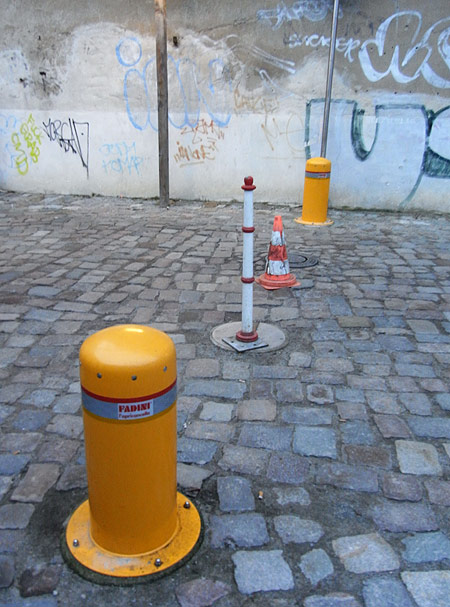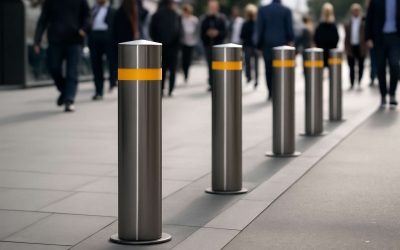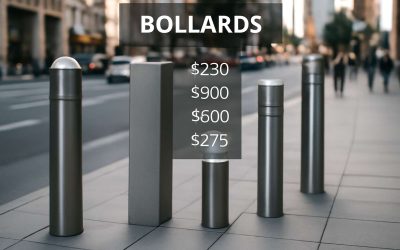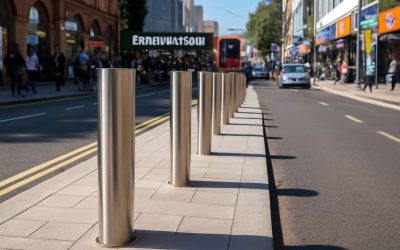Understanding Bollards and Their Functions
What Are Bollards?
In the intricate dance of urban design, bollards serve both as guardians and gatekeepers, subtly shaping human movement and vehicle flow. An often overlooked detail—yet critically important—is the bollards distance between each post. This measurement is not merely a matter of aesthetics; it directly influences safety, accessibility, and effective traffic management. A well-calculated bollards distance between can prevent vehicles from encroaching on pedestrian zones while maintaining an inviting environment for foot traffic.

Understanding bollards and their functions reveals that these sturdy posts do more than just delineate boundaries. They act as protective barriers against reckless drivers, protect infrastructure, and sometimes even serve as decorative elements. When considering the bollards distance between, planners and architects must balance the need for security with visual harmony, ensuring that the spacing neither hampers pedestrian flow nor leaves gaps vulnerable to intrusion. For those seeking optimal placement, considering factors such as vehicle size, speed, and surrounding architecture is essential—after all, a misjudged bollards distance between can either turn into a pointless obstacle or a security loophole.
Types of Bollards
Understanding bollards and their functions reveals a layered complexity that extends beyond mere boundary setting. These resilient posts embody a delicate balance—standing firm against threats while allowing fluid human movement. As guardians of safety, they often become silent witnesses to the moral dilemmas of urban life, where security and accessibility intersect. The bollards distance between each post is not a trivial measurement; it is a reflection of societal priorities, a physical manifestation of our collective desire for protection without alienation.
Different types of bollards serve varied purposes, from retractable barriers that offer flexibility to fixed posts that assert unwavering security. Each type demands a nuanced approach to their placement, where the bollards distance between becomes a matter of existential significance. For instance, in high-security zones, a tighter spacing enhances protection, while broader gaps foster openness and invite community interaction. Recognising these distinctions underscores the importance of precise measurements—because, in the realm of urban safety, the bollards distance between can determine whether a space becomes a fortress or a gathering place.
Common Uses of Bollards in Urban Design
Understanding bollards and their functions reveals their vital role in shaping urban landscapes. Beyond simple markers, bollards act as protectors of pedestrians, traffic regulators, and even statements of public policy. Their strategic placement influences how spaces are used and perceived, making the bollards distance between each post a critical factor. Proper spacing can mean the difference between a welcoming street and an impenetrable barrier.
Common uses of bollards in urban design highlight their adaptability. They can be decorative, retractable, or fixed, each serving distinct purposes. For example, in busy commercial districts, bollards are placed with a specific bollards distance between to optimise safety without obstructing flow. Conversely, in areas requiring heightened security, tighter spacing enhances protection. This nuanced approach ensures safety measures do not alienate those they aim to protect.
- Traffic management and pedestrian safety
- Creating barriers for vehicle restrictions
- Enhancing aesthetic appeal of public spaces
Ultimately, the precise measurement of the bollards distance between posts reflects the societal priorities of safety, accessibility, and community interaction. It’s a delicate balancing act—one that requires careful consideration of context and purpose. When designed thoughtfully, bollards serve as silent guardians, shaping the urban environment in both function and form.
Importance of Proper Bollards Distance Between
Safety and Security
In a world where urban landscapes are increasingly designed with both form and function in mind, the bollards distance between becomes a vital consideration—not just for aesthetics, but for safety and security. When bollards are placed too close, they risk creating a cluttered environment that hampers pedestrian flow; too far apart, and they fail to serve their protective purpose effectively. Striking the right balance is an act of subtle engineering, rooted in understanding human behaviour and spatial psychology.
Proper bollards distance between pedestrian zones and vehicular pathways isn’t merely a matter of measurements; it’s a reflection of our collective need for safety and order. An optimal arrangement can serve as a silent guardian, shielding the vulnerable while maintaining an inviting urban space. Conversely, an imbalance can provoke chaos, inviting danger or fostering a false sense of security. The intricate dance of placement underscores a profound truth: the spacing of bollards isn’t just technical—it’s an existential act of safeguarding human life.
Traffic Management
In the intricate theatre of urban design, the spacing of bollards holds more than mere aesthetic value—it embodies a silent pact with human safety. The bollards distance between isn’t a simple measurement; it’s a reflection of our unspoken need for order amidst chaos. When the distance is too narrow, pedestrian flow becomes stifled, transforming public spaces into cluttered corridors. Conversely, an overly generous gap leaves vulnerable areas exposed, risking the very security these structures aim to uphold.
Striking the perfect balance requires a nuanced understanding of human behaviour and spatial psychology. Effective traffic management hinges on this delicate equilibrium—where safety meets accessibility. Consider these principles:
- Maintaining a consistent bollards distance between ensures clear delineation of pedestrian zones and vehicular pathways.
- Proper spacing acts as an unassuming sentinel, guiding movement without obstructing sightlines or creating visual clutter.
Ultimately, the correct bollards distance between is an existential consideration—an act of moral responsibility woven into the fabric of urban life, safeguarding human lives while honouring the integrity of shared spaces. It’s a subtle dance that transcends measurement, touching on the core of human trust and safety in our cities.
Accessibility and Pedestrian Safety
In the grand choreography of urban safety, the bollards distance between each post isn’t just a matter of measurement—it’s a vital thread weaving safety, accessibility, and harmony into the fabric of city life. When the bollards distance between is too narrow, pedestrian zones risk becoming congested labyrinths, stifling movement and dampening the vibrancy of public spaces. On the other hand, an excessive gap can leave vital areas exposed, inviting danger where protection is most needed.
Striking a delicate balance requires more than mere intuition; it demands an understanding of human behaviour and spatial psychology. Properly spaced bollards guide movement seamlessly, creating clear boundaries without obstructing sightlines or creating visual clutter. This careful calibration ensures that pedestrians feel both secure and free to navigate their environment with confidence.
- Ensuring consistent bollards distance between enhances pedestrian safety by clearly delineating zones.
- Optimal spacing acts as an unassuming sentinel, silently maintaining order while fostering accessibility.
Ultimately, the importance of the bollards distance between resonates beyond mere aesthetics; it embodies a moral commitment to protecting lives and maintaining the integrity of our shared urban spaces. When thoughtfully executed, it transforms bustling streets into safe, welcoming corridors—where every step is guided by trust and purpose.
Factors Influencing Bollards Spacing
Location and Environment
The arrangement of bollards within urban environments is far more nuanced than simply placing them at random intervals; it reflects a deeper dialogue between design, functionality, and social harmony. One of the most pivotal factors influencing bollards distance between is the specific environment in which they are installed. For pedestrian zones, a closer bollards distance between ensures a clear boundary that protects foot traffic without impeding movement. Conversely, in areas with vehicular access, the spacing must balance safety and traffic flow, preventing accidental collisions while maintaining aesthetic integrity.
Environmental considerations also play a vital role. For example, in coastal regions, corrosion-resistant bollards may require different spacing to accommodate salt exposure and wind effects. Additionally, the location’s social context can dictate the bollards distance between—public plazas might benefit from flexible spacing to encourage community interaction, whereas strict parameters are essential in high-security zones. Ultimately, the optimal bollards distance between hinges on a complex interplay of design intent, safety standards, and environmental factors, shaping the very fabric of urban safety and accessibility.
Traffic Volume and Speed
Traffic volume and speed have a profound impact on the bollards distance between. In high-traffic areas where vehicles move swiftly, bollards need to be spaced further apart to prevent accidental collisions while maintaining visual clarity. Conversely, in zones with lower speed limits, tighter spacing can be implemented to reinforce pedestrian safety without obstructing movement. This delicate balance ensures that bollards serve their purpose effectively without disrupting flow or aesthetic harmony.
Urban planners often consider the following factors when determining the bollards distance between:
- Vehicle speed and volume
- Type of traffic (pedestrian, cyclist, vehicular)
- Safety standards and regulations
- Environmental conditions that may influence durability
By carefully analysing these elements, it’s possible to optimise the bollards distance between, ensuring urban spaces remain safe, accessible, and visually cohesive. After all, the right spacing isn’t just about safety; it’s about creating a balanced environment that respects both human and vehicular needs.
Bollard Material and Design
When it comes to establishing the perfect bollards distance between, the choice of material and design plays a pivotal role. Strong, durable materials like stainless steel or concrete not only withstand the relentless march of time but also influence how far apart each bollard must be placed to ensure optimal safety and aesthetic harmony. The design—be it slender and sleek or robust and imposing—affects visibility and the visual rhythm of the urban landscape. Intriguingly, the aesthetic appeal of a well-crafted bollard can transform a mundane street into a captivating promenade.
Consider the environmental conditions and the intended function of the bollards, which can dramatically impact spacing decisions. For example, in areas prone to harsh weather or high vehicular impact, thicker or reinforced bollards may require closer bollards distance between to provide consistent protection. Conversely, in scenic pedestrian zones, a more generous spacing enhances visual flow and encourages leisurely movement. Ultimately, the material and design choices intertwine to determine the optimal bollards distance between, creating a balanced environment that is both functional and visually engaging.
Legal Regulations and Standards
In the intricate dance of urban design, the bollards distance between isn’t just a random number plucked from thin air. It’s a careful calculation influenced by legal regulations and standards, ensuring both safety and compliance. Local authorities often set strict guidelines to prevent pedestrian zones from turning into chaotic free-for-alls or, worse, accident zones. These regulations typically specify minimum and maximum spacing to maintain effective barriers while allowing visual openness.
Understanding the legal landscape is crucial. For instance, some jurisdictions mandate that bollards be spaced no more than 1.2 metres apart in high-risk areas, while others might allow more generous gaps for aesthetic reasons. To navigate this maze, consider these factors:
- The intended purpose of the bollards
- Local safety standards and building codes
- Urban environment and surrounding infrastructure
Adhering to these standards isn’t merely bureaucratic red tape; it’s about creating a harmonious balance between functionality, aesthetics, and legal compliance. After all, nobody wants their carefully curated streetscape to fall foul of regulations—or worse, cause harm due to overlooked spacing requirements.
Recommended Bollards Distance Between Guidelines
Standard Spacing for Pedestrian Areas
Choosing the right bollards distance between is more than just a matter of aesthetics; it’s a crucial element in pedestrian safety and urban flow. An optimal spacing ensures that pedestrians can navigate comfortably without feeling like they’re walking through a fortress of steel. Typically, the recommended bollards distance between ranges from 1.2 to 2 metres, depending on the environmental context and intended purpose.
In high-traffic pedestrian zones, a tighter bollards distance between—closer to 1.2 metres—acts as a formidable barrier against rogue vehicles, while still allowing easy passage for foot traffic. Conversely, wider spacing might be suitable for areas prioritising visual openness or accommodating mobility aids.
Understanding the standard spacing for pedestrian areas can make all the difference in creating a seamless, safe urban experience. After all, the devil is in the details, and a well-planned bollards distance between can turn a chaotic street into a well-orchestrated promenade.
Spacing for Vehicle Barriers
In the realm of urban design, the seemingly simple question of bollards distance between can dramatically influence the harmony between safety and aesthetics. An optimal spacing acts as an invisible guardian—delicately balancing accessibility with protection. Studies suggest that a well-calibrated bollards distance between 1.2 and 2 metres can serve as a formidable yet unobtrusive barrier, guiding traffic and pedestrians with equal finesse.
For vehicle barriers, understanding the recommended bollards distance between is crucial. Tighter spacing—closer to 1.2 metres—fortifies pedestrian zones against errant vehicles, creating a resilient shield without sacrificing walkability. Conversely, areas that embrace visual openness or require the accommodation of mobility aids often benefit from a wider bollards distance between, perhaps nearing 2 metres, allowing for smooth pedestrian flow.
In essence, the magic lies in tailoring the bollards distance between to the specific environment—ensuring that each urban masterpiece functions as a seamless, secure canvas for daily life. After all, in the intricate dance of city planning, the spacing between bollards is a subtle but powerful step that can elevate an ordinary street into an extraordinary promenade.
Optimizing Visibility and Accessibility
The subtle art of defining the bollards distance between reveals more than just spatial arrangement—it embodies a delicate balance between security and human experience. When considering optimal spacing, it’s essential to understand that the right bollards distance between can transform a functional barrier into a seamless extension of urban life. An overly tight configuration might impede visibility and accessibility, while excessive spacing could undermine safety.
Research indicates that a carefully calibrated bollards distance between 1.2 and 2 metres can optimise both safety and flow. Narrower spacing, closer to 1.2 metres, creates an almost impenetrable shield that guards pedestrians against errant vehicles without sacrificing walkability. Conversely, a wider bollards distance between 1.8 and 2 metres fosters a sense of openness, vital for accommodating mobility aids and ensuring unobstructed movement.
Ultimately, tailoring the bollards distance between to the specific context—considering traffic volume, pedestrian behaviour, and aesthetic aims—elevates urban design from mere practicality to a reflection of collective human intent. The spacing isn’t just about measurements; it’s about sculpting environments that respect both safety and the human desire for openness and connection.
Design Considerations for Bollards Placement
Aligning with City Planning Standards
Design considerations for bollards placement are far more nuanced than simple spacing; they embody a delicate balance between safety, aesthetics, and urban flow. When aligning with city planning standards, understanding the optimal bollards distance between each barrier is crucial to ensuring pedestrian safety without hindering accessibility. These standards are often rooted in comprehensive traffic studies and social needs, reflecting a city’s unique character and functional demands.
Achieving harmony in bollard placement requires thoughtful analysis of environmental factors and human behaviour. For instance, in high foot traffic zones, the bollards distance between may need to be reduced to prevent accidental entry, while in vehicle-dense areas, greater spacing ensures efficient traffic management. It’s not merely about uniformity but about creating a seamless interaction between infrastructure and people. Urban designers often employ a combination of empirical data and imaginative foresight, ensuring that every bollard contributes to the city’s rhythm rather than disrupting it.
Aesthetic Factors
Designing the perfect placement of bollards is an art that balances visual harmony with functional precision. When considering the bollards distance between each barrier, aesthetic appeal often takes centre stage alongside practical concerns. A well-chosen spacing can elevate an urban landscape, transforming utilitarian safety features into elements of visual storytelling. The interplay of shadows, light, and materials can make a series of bollards appear almost poetic, guiding pedestrians with subtle elegance.
Achieving this delicate balance requires an eye for detail and an understanding of social dynamics. In high-traffic zones, reducing the bollards distance between can create a sense of enclosure and safety, while in more open areas, greater spacing fosters a sense of openness and flow. A thoughtful approach might include considering the surrounding environment and how people interact with the space. Sometimes, an irregular pattern or varying distances can evoke a sense of rhythm, making the urban environment feel alive and inviting.
Incorporating aesthetic factors into bollards placement involves more than just measurements. It’s about crafting a narrative that complements the city’s character. The following considerations are often integrated into design decisions:
- Material and colour choices that blend seamlessly with existing architecture
- Shape and size variations to add visual interest
- Lighting integration to enhance safety and aesthetics after sunset
Maintenance and Durability
In the intricate dance of urban design, the bollards distance between each barrier is a subtle yet potent element that influences both durability and visual harmony. Proper placement requires an acute awareness of environmental stressors—exposure to weather, vandalism, and the relentless march of time demand that each bollard’s construction withstands the rigours of daily life. When considering the bollards distance between, it’s essential to strike a balance that ensures longevity without compromising aesthetic integrity.
Strategically, the maintenance of bollards involves selecting materials that resist corrosion and wear—such as stainless steel or reinforced concrete—while also contemplating ease of access for repairs. The spacing must facilitate straightforward inspection and upkeep, avoiding tight clusters that complicate maintenance routines. Think of it as an ongoing dialogue between form and function—where the choice of durability and the precise bollards distance between each barrier coalesce into an enduring urban feature, resilient against the passage of years and the unpredictability of their environment.
Common Mistakes to Avoid When Installing Bollards
Incorrect Spacing
Even a small miscalculation in the bollards distance between installations can have significant repercussions. Improper spacing often leads to compromised safety, reduced accessibility, or visual clutter that diminishes the urban aesthetic. One common mistake is placing bollards too close together, which can obstruct pedestrian flow and create an uninviting environment. Conversely, spacing them too far apart defeats their intended purpose of protection and control.
To avoid these pitfalls, it’s crucial to understand the nuanced requirements for different environments. For example, pedestrian zones typically require a specific bollards distance between to ensure ease of movement, while vehicle barriers demand larger gaps to accommodate traffic flow. Failing to adhere to these standards can undermine both the safety and functionality of your installation. Remember, the key lies in selecting a bollards distance between that balances security, accessibility, and urban appeal.
Poor Material Choices
Choosing the right bollards distance between installations isn’t just a matter of measurement—it’s a dance of precision that can transform urban spaces from chaotic to harmonious. Poor material choices for bollards can undermine this delicate balance, turning what should be a sturdy barrier into a fragile illusion. Imagine installing bollards with materials that crack under stress or degrade swiftly; such missteps leave safety and aesthetic harmony hanging by a thread. When selecting materials, consider durability, environmental resistance, and visual appeal, ensuring each bollard stands resilient through the seasons.
One common mistake is neglecting the importance of appropriate bollards distance between units, which, when misjudged, can lead to compromised security or obstructed pedestrian flow. To avoid these pitfalls, it’s vital to think beyond mere measurements and embrace a holistic approach—balancing materials, spacing, and environmental factors. Remember, the right bollards distance between installations safeguards both functionality and visual elegance, creating a seamless urban experience that invites trust and admiration.
Ignoring Local Regulations
When it comes to installing bollards, overlooking local regulations can be a costly oversight. Regulations form the backbone of urban safety and aesthetic coherence, guiding the precise bollards distance between units to ensure optimal function. Ignoring these standards not only risks legal repercussions but also compromises safety and efficiency. Municipal codes often specify minimum and maximum spacing to balance security with pedestrian flow, making their adherence crucial for a seamless urban environment.
Many installers fall into the trap of relying solely on generic measurements, neglecting the nuanced requirements set by local authorities. This can lead to overcrowding or gaps that are too wide, defeating the purpose of a bollard installation. To navigate this complexity, consider consulting city planning documents or engaging with local authorities to clarify the recommended bollards distance between. Remember, each city’s standards are tailored to its unique traffic patterns and safety needs, which should never be overlooked.
In essence, respecting local regulations isn’t just about compliance; it reflects a commitment to creating spaces that are both safe and harmonious. Ensuring the correct bollards distance between installations fosters a cohesive environment where safety, accessibility, and aesthetic appeal coexist. Ignoring these guidelines risks undermining the very purpose of bollards — to protect and organise urban spaces effectively.
Consulting Professionals for Bollards Installation
Why Hire Experts?
In the complex dance of urban design, the importance of consulting professionals for bollards installation cannot be overstated. When it comes to determining the optimal bollards distance between, expertise ensures that safety, accessibility, and aesthetic harmony are seamlessly balanced. A misjudged spacing can undermine pedestrian safety or fail to deter unwelcome vehicle intrusion, leading to costly repercussions.
Choosing seasoned specialists means embracing a meticulous approach rooted in understanding human behaviour, environmental factors, and regulatory standards. They assess variables such as traffic volume, pedestrian flow, and the physical environment to establish precise bollards distance between, thereby enhancing both functionality and visual appeal. Moreover, their insight helps prevent common pitfalls like incorrect spacing or poor material choices, which compromise durability and safety.
Ultimately, engaging experts elevates the entire process from mere installation to creating resilient, thoughtfully designed urban spaces. Their guidance transforms utilitarian bollards into strategic elements—silent guardians that respect both human needs and civic aesthetics.
Choosing the Right Service Provider
In the labyrinth of urban design, where every metre counts and safety hangs in delicate balance, consulting professionals for bollards installation is paramount. The seemingly simple question of bollards distance between can profoundly influence pedestrian safety, traffic flow, and visual harmony. Expert guidance ensures that each bollard is positioned with meticulous precision, transforming utilitarian objects into silent custodians of space.
Choosing the right service provider involves more than just selecting a contractor; it demands a partnership with specialists who understand the nuances of environmental factors, human behaviour, and regulatory standards. Their seasoned eye discerns the optimal bollards distance between, tailored to the unique rhythm of each locale. This careful calibration enhances functionality while preserving aesthetic integrity, safeguarding both city dwellers and civic beauty.
When seeking exemplary service, consider providers who approach each project with a keen understanding of local traffic patterns, pedestrian needs, and material resilience. An experienced team evaluates variables such as traffic volume and speed, ensuring that the bollards distance between aligns seamlessly with safety requirements. Their expertise transforms the installation from a mere task into a strategic act of urban harmony—an art woven into the fabric of city life.
Ensuring Compliance with Regulations
In the intricate dance of urban safety and design, professional consultation on bollards installation is not merely advisable—it is essential. Regulations surrounding the bollards distance between must be adhered to scrupulously, as even the tiniest misjudgment can compromise safety, accessibility, and aesthetic harmony. Experts in the field possess an almost intuitive grasp of these standards, ensuring every bollard is positioned with deliberate intent.
Understanding the precise bollards distance between is a matter of balancing functional necessity with visual coherence. An adept professional doesn’t just measure; they interpret the spatial rhythm of each environment, considering factors like pedestrian flow and vehicle speed. This nuanced approach transforms what might seem like a simple measurement into a strategic element of urban planning.
By engaging seasoned specialists, you gain more than technical expertise—you access a depth of insight that safeguards against common pitfalls such as incorrect spacing or poor material choices. Their meticulous evaluation of local regulations guarantees compliance, turning installation into an act of civic responsibility. Ultimately, harmonious integration of bollards, guided by expert advice, shapes cityscapes that are as safe as they are stunning—an enduring testament to thoughtful design.



0 Comments